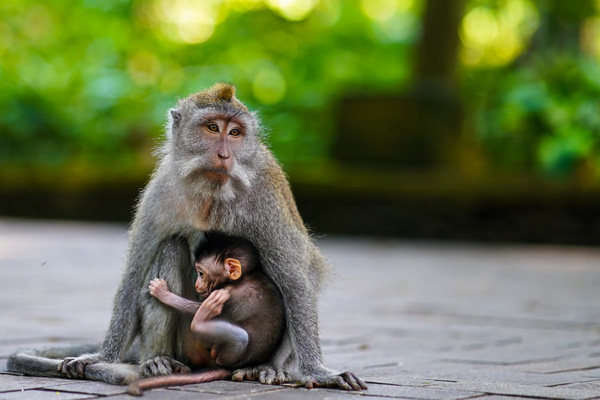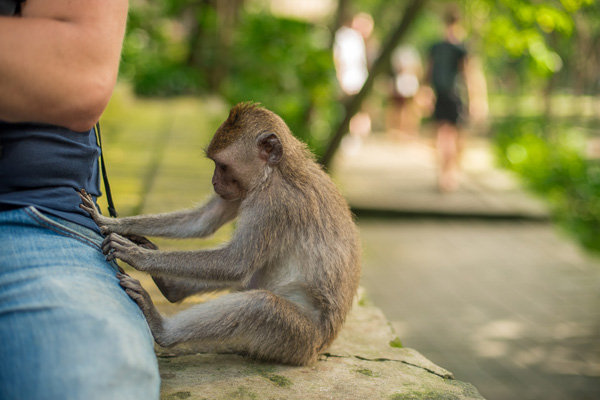Things to Do in Bali
Your Ultimate Bali Monkey Guide
Monkeys in Bali – What to Know About Sacred Macaques, Temples & Monkey Forests
You don’t have to go looking for monkeys in Bali — chances are, they’ll find you first. Whether you’re exploring a temple in Uluwatu, wandering the Monkey Forest in Ubud, or staying near the cliffs of Nusa Dua, you’ll quickly notice: monkeys are part of the landscape here.
They’re not pets, not zoo animals, and not always gentle. But they are deeply woven into Balinese culture and mythology — seen as spiritual messengers, sacred guardians, and sometimes mischievous tricksters. In Bali, monkeys live in their own world, and we’re simply visitors in it.
Interesting Facts
Did You Know? – Monkey Wisdom in Bali
- Monkeys in Bali are considered temple guardians — especially at cliffside sites like Uluwatu. Their presence is thought to scare away bad spirits.
- The long-tailed macaque is the most widespread monkey in Southeast Asia, but Bali’s temple monkeys have developed unique behaviors due to constant human interaction.
- At Uluwatu Temple, monkeys have learned to “barter” — stealing sunglasses or hats and trading them back for food offered by local guides. Researchers have studied this as an example of animal innovation.
- Some Balinese believe that harming a monkey brings bad luck, especially near temples. This belief helps protect the monkeys — even when they misbehave.
- The word “wanara” means monkey in ancient Javanese and Balinese — and is part of the name of Ubud’s Monkey Forest: *Mandala Suci Wenara Wana*.
- Female macaques often pass on social knowledge to their young — including how to interact with humans, find food, and navigate temple zones.
- Poleng cloth (black-and-white checks) is sometimes seen wrapped around monkey statues — symbolizing their role in the cosmic balance of good and bad forces.
- Monkeys have sharp canine teeth and complex emotions — including jealousy and revenge. Feeding or teasing them can shift their entire group’s mood.
- Balinese cremation ceremonies may avoid forested areas where monkeys live, out of respect for the spirits said to inhabit wild animals.
- Some temple priests still leave offerings specifically for the monkeys, especially in older sites where macaques have been present for centuries.
What Kind of Monkeys Live in Bali?
The monkeys most commonly seen in Bali are long-tailed macaques (Macaca fascicularis). They’re native to Southeast Asia and can live in forests, temple complexes, and even urban areas.
They’re highly intelligent, social animals that live in troops, with a clear hierarchy and strong family bonds. Adults have long tails, expressive faces, and sharp instincts. And while they may seem curious or playful, they can also be territorial — especially if food is involved.
Important to know: These are wild animals, not domesticated or tamed. Even in the famous monkey forests, they are free-roaming and can bite or scratch if provoked or cornered.

Monkeys in Balinese Culture & Religion
In Balinese Hinduism, monkeys hold a respected — and sometimes feared — place in the spiritual order. They are seen as both sacred and unpredictable. The mythological figure Hanuman, the monkey god from the Hindu epic Ramayana, is honored in Balinese temples as a symbol of courage, devotion, and protection.
You’ll often see monkeys around temples, not just because of the trees and offerings, but because their presence is seen as auspicious. They are believed to guard the sacred spaces from negative spirits — although some locals might joke that the monkeys cause more chaos than they prevent.
In traditional Balinese worldview, the monkey embodies the balance of dual forces — playful yet dangerous, holy yet wild — much like the duality symbolized in the poleng cloth worn by priests and statues.
Where to See Monkeys in Bali
You can see monkeys in several forests and temple complexes across Bali. Some have become famous tourist spots, while others are more off the beaten track. Here are the most well-known places:
🐒 Ubud Monkey Forest (Mandala Suci Wenara Wana)
Located in the heart of Ubud, this sacred forest sanctuary is home to over 1,000 macaques. The paths wind through towering trees, ancient temples, and moss-covered statues. It’s a peaceful yet lively place, where monkeys swing freely and occasionally grab a water bottle or sunglasses.
Tip: Don’t bring food. Keep your bag closed. Stay calm and respectful.
🐒 Uluwatu Temple
Perched on the cliffs of Bali’s southern peninsula, Uluwatu is home to a notorious monkey population. These macaques are bold and opportunistic — known for snatching glasses, phones, and hats, then trading them back for fruit from temple guards.
Tip: Remove anything shiny or loose before entering. The views are stunning, but stay alert.
🐒 Sangeh Monkey Forest
Located in Badung Regency, this forest is older and less crowded than Ubud’s, with giant nutmeg trees and a peaceful temple in the center. The monkeys here are calmer and less aggressive — a great option for families or those wanting a more relaxed experience.
🐒 Alas Kedaton
Near Tabanan, this smaller forest is also home to fruit bats and a lovely temple complex. The atmosphere is quiet and often less touristy than the big-name spots.
🐒 Nusa Dua Cliffside & Resort Areas
Surprisingly, wild macaques also roam freely around the cliffs and hotel gardens in Nusa Dua and southern Bali. They’re less concentrated, but just as clever — and just as interested in unattended snacks.
How to Interact Safely and Respectfully with Monkeys in Bali
Seeing monkeys up close is a unique part of the Bali experience — but it’s important to approach them with awareness and respect. Here’s what you need to know:
✔️ Do:
- Keep your distance. Monkeys may approach you, but you shouldn’t approach them.
- Secure your belongings. Zippers, backpacks, sunglasses, water bottles — monkeys are curious and quick.
- Stay calm. If a monkey jumps on you or grabs something, don’t scream or panic. Stay still and wait for it to leave, or ask a local guide for help.
- Respect their space. Never block a monkey’s path or separate a baby from its mother — this can provoke a defensive reaction.
- Observe quietly. The most meaningful moments often come from simply watching their behavior in silence.
- Watch your kids. Don’t let them touch the monkeys or allow a monkey to climb on them — even if it seems friendly at first. Things can escalate quickly if a child panics. Be cautious and never let children feed monkeys.
❌ Don’t:
- Don’t feed the monkeys. Even if it seems harmless, feeding encourages aggression and dependency. Most temple sites now prohibit it. While some monkey forests still sell bananas or peanuts for feeding, it can quickly become stressful — and dangerous — if you’re not careful.
- Don’t make eye contact or smile with teeth. In monkey language, this can be seen as a threat or challenge.
- Don’t carry food, even hidden. Monkeys can smell it and may try to steal it from your bag or pockets.
- Don’t tease or provoke. Flashing a banana and then hiding it? That’s not fun for the monkeys — and it often ends badly.
Monkeys, Tourism & Ethical Awareness
Over the years, the behavior of some monkey groups in tourist areas has changed. In places like Uluwatu and Ubud, monkeys have learned that stealing sunglasses or hats may result in a snack — a learned behavior shaped by human presence. This is not “natural mischief” — it’s a sign of how sensitive wildlife is to our actions.
That’s why most temples and monkey forests now advise against feeding, touching, or teasing monkeys. It’s not only safer for you — it also protects the health and long-term wellbeing of the monkeys themselves.
Wild animals should remain wild. When we treat them as entertainment, it harms their social structure and changes their behavior, sometimes making them more aggressive or dependent on humans. Ethical wildlife tourism begins with boundaries and respect.
Living with Monkeys in Bali
In Bali, the line between the human world and the natural world is thin. Monkeys live alongside temples, tourists, priests, and shopkeepers — both welcomed and feared, protected and tolerated. They’re not here for our amusement. They’re part of something older and wilder than any of us.
So when you encounter monkeys in Bali, pause. Watch. Listen. Leave them be. And remember: in their world, we are the visitors.
Meet the Monkeys – Biology, Behavior & Conservation
The monkeys you see in Bali are long-tailed macaques (Macaca fascicularis). Also known as crab-eating macaques, they’re one of the most adaptable primates in Asia — equally at home in forests, temples, rice fields, and even urban neighborhoods. But behind those expressive faces and playful antics is a complex social animal with strong instincts and deep family bonds.
Basic Facts
- Species: Long-tailed macaque (Macaca fascicularis)
- Lifespan: 20–30 years in the wild
- Size: Males up to 60 cm tall; females slightly smaller
- Weight: Males: 5–7 kg; Females: 3–5 kg
- Tail: Nearly as long as the body — used for balance in trees
Social Life & Behavior
Macaques live in matrilineal troops of 20–80 individuals, led by a dominant female. Males may migrate between groups, while females typically stay in their birth troop. Social grooming is a big part of daily life — not just for hygiene, but for bonding and calming tensions.
Hierarchy is everything. Status affects access to food, mates, and even protection. Young monkeys learn their place early — and those born to high-ranking mothers often rise more easily.
Reproduction
- Gestation: ~165 days (about 5.5 months)
- Births: Usually one infant, rarely twins
- Infant care: Mothers carry and nurse for 6+ months; other females may help care for young
- Sexual maturity: Females: ~3 years, Males: ~4–5 years
Baby macaques cling to their mother’s belly in the early weeks, then shift to riding on her back. They’re extremely dependent and watched closely by the troop.
What Monkeys Need to Thrive
- Tree canopy for sleeping, shade, and safety
- Fresh water and wild foraging areas
- Minimal human interference — especially no feeding or crowding
- Social stability within troops, without disruption from tourism
Are They Threatened?
Globally, long-tailed macaques are listed as “Vulnerable” on the IUCN Red List (2022) due to **declining populations**, habitat loss, illegal wildlife trade, and overexposure to tourism in some regions — including Bali.
Ironically, the monkeys we see most often are the ones most at risk of becoming dependent on humans. Changes in diet and behavior from being fed can lead to stress, aggression, and malnutrition. And when troops move closer to roads and hotels, they’re vulnerable to injury or conflict.
How to Help
The best way to support Bali’s monkeys is to let them stay wild. Don’t feed them. Avoid teasing or chasing. Support responsible monkey sanctuaries that prioritize education and conservation. And always remember: they’re not here for us — we’re sharing the island with them.























